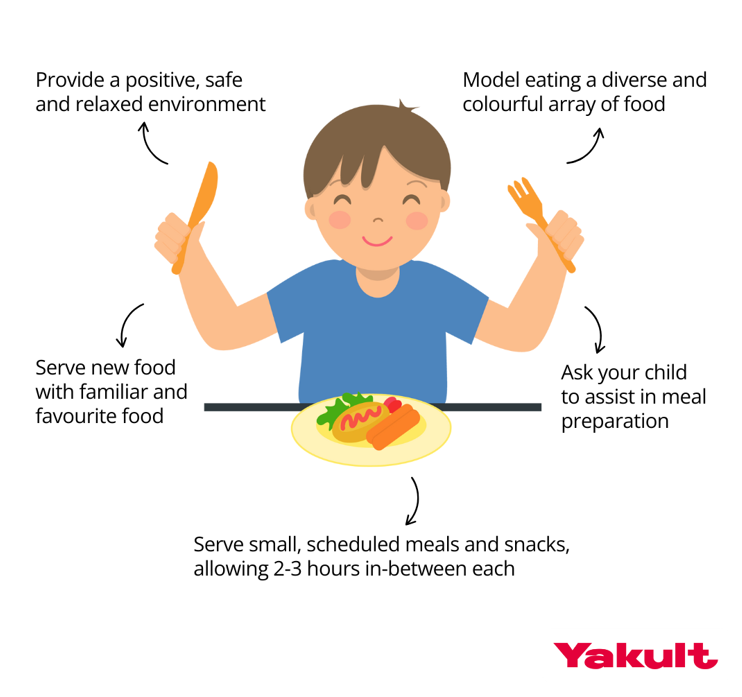If you’re a parent, chances are you’ve likely encountered situations where your child has vocalised their own preferences, likes and dislikes about certain types of food. If you have, rest assured you are not alone in this experience!
This blog is designed as a helpful guide for parents to better understand picky eating in children and offers evidence-based strategies to support your child during mealtimes!
What is Picky Eating?
Picky eating –also known as fussy, faddy or selective eating– is a common food behaviour that occurs during childhood and is generally considered a normal part of growth and development (1,2). While there is currently no universal clinical definition of picky eating, it is typically defined as the reluctance or refusal to eat foreign or familiar food that may differentiate in colour, taste, texture, or appearance (1,3). In fact, research shows that around 50% of children under the age of 3 refuse to consume new food at least half of the time (4). Picky eating is most prevalent between the ages of 2 and 6, affecting an estimated 6-50% of preschoolers aged 2-5, and 19-59% of primary school children aged 6-12 (5).

Picky eating is often a temporary phase; however persistent and long-term picky eating may potentially affect the health and development of your child. Encouraging healthy eating habits from an early age can help build positive relationships with food! (2)
Nutrition and health considerations in picky eating:
- Food diversity: Introducing a variety of foods from all major food groups, such as grains, fruits, vegetables, meat, and dairy, can help expand a picky eater’s palate and support balanced nutrition (1). With patience and creativity, mealtimes can become a fun opportunity to explore new tastes and textures.
- Key nutrients: Encouraging a variety of foods can help picky eaters increase their intake of key nutrients such as protein, iron, zinc, vitamin D and vitamin A, which are essential for supporting optimal growth and development (1).
- Digestion: Low fibre consumption from fruits and vegetables can lead to hard stools and constipation (3). Consider incorporating fermented drinks containing probiotics (such as Yakult), along with a diet rich in fruits and vegetables to support gut health and regulate bowel movements (6).
- Growth and development: Encouraging a balanced and nutrient-rich diet helps children maintain a healthy weight (3). Providing a variety of whole foods gives their bodies the fuel they need to grow strong, stay active, and thrive.
If you are concerned about your child’s picky eating patterns, it’s best to see your healthcare professional for advice. While picky eating can be tricky to navigate, the good news is that there are simple, evidence-based strategies you can use to support your child!
Some mealtime strategies for children:
Foster a supportive eating environment:
- Provide a positive, relaxed and safe eating environment free from distractions. Avoid television, electronics, toys or books during mealtimes (7).
- Enjoy eating meals together as a family to support the development of social skills (2,7).
- Avoid pressuring or forcing your child if they refuse to try a new food. Children’s preferences often change, so attempt again after a few days or weeks as it may take up to ten repeated exposures before a child accepts a new food (7).
Establish structure during mealtimes:
- Serve age-appropriate portion sizes according to your child’s developmental stage. Start with reasonable portions (eg. the size of the child’s fist), and a general rule of thumb is to offer one tablespoon of each food per year of the child’s age (eg. a 2-year-old can start with 2 tablespoons of broccoli, 2 tablespoons of rice, and 2 tablespoons of chicken). Depending on the child’s appetite, bigger serving sizes can be offered if they are still hungry (7).
- Serve small, scheduled meals and snacks, allowing 2-3 hours in-between each to encourage the child’s natural appetite and hunger to develop before their next meal (7).
- Offer drinks such as water and milk towards the end of a meal or snack instead of before, to prevent filling up their stomach (7).
- Aim to keep mealtimes between 20-30 minutes. At the end of the meal, calmly remove your child’s plate without any fuss. If they did not eat much of their food, provide a nutritious snack later or wait until the next meal (2).
Support autonomy:
- Ask your child to assist you in meal preparation, as they may feel more inclined to eat a meal they have helped to cook (2).
- Encourage your child to feed themselves and use their hands to explore new food from an early age. This fosters independence and curiosity as they learn about new food through touch (2).
Introduce and encourage new foods:
- Provide alternative food options from each food group. For instance, if your child dislikes cheese, try offering yoghurt instead (2).
- Serve new food with familiar and favourite food to reduce resistance (2,7).
- Model eating a diverse and colourful array of food (such as fruits and vegetables) as it encourages healthy eating patterns and acceptance (2,3,7).

Figure 1. Mealtime strategies to support picky eating in children (2,3,7)
Remember progress takes time, and every bite counts! By fostering a supportive, positive and calm eating environment, you will be providing your child with the skills that build confidence, independence, and lifelong healthy eating habits!
References:
- Wolstenholme H, Kelly C, Hennessy M, Heary C. Childhood fussy/picky eating behaviours: a systematic review and synthesis of qualitative studies. Int J Behav Nutr Phys Act. 2020;17(1):2. doi:10.1186/s12966-019-0909-5
- Better Health Channel. Toddlers and Fussy Eating. Accessed August 7, 2025. https://www.betterhealth.vic.gov.au/health/healthyliving/toddlers-and-fussy-eating
- Taylor CM, Emmett PM. Picky eating in children: causes and consequences. Proc Nutr Soc. 2018;77(4):1–9. doi:10.1017/S0029665118002586.
- Healthy Eating Advisory Service. Introducing new foods to children Accessed August 7, 2025. https://heas.health.vic.gov.au/resources/promoting-healthy-eating/introducing-new-foods-to-children/
- Jani R, Byrne R, Love P, Agarwal C, Peng F, Yew YW, et al. The environmental and bitter taste endophenotype determinants of picky eating in Australian school-aged children 7–12 years—A cross-sectional pilot study protocol. Int J Environ Res Public Health. 2020 Mar;17(5):1573. doi:10.3390/ijerph17051573.
- Yakult Australia. Benefits. Published April 30, 2025. Accessed May 26, 2025. https://www.yakult.com.au/benefits/
- Ong C, Phuah KY, Salazar E, How CH. Managing the ‘picky eater’ dilemma. Singapore Med J. 2014 Apr;55(4):184–90. doi:10.11622/smedj.2014049.
